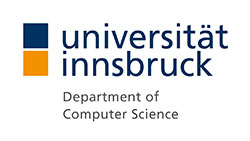Spreading excellence and disseminating the cutting edge results of our research and development efforts is crucial to our institute. Check for our educational offers for Bachelor, Master and PhD studies at the University of Innsbruck!
Information-centric Opportunistic Data Dissemination in Vehicular Ad-hoc Networks
Multi-hop wireless exchange of information between vehicles requires sophisticated data dissemination strategies which can not be fulfilled by traditional routing protocols. Data dissemination strategies for Vehicular Ad-hoc Networks (VANETs) may exploit greedy information-centric routing, interest-based data diffusion, and store-and-forward capabilities among others. The main objective of this master thesis will be the theoretical and practical development of strategies for the dissemination of information and an evaluation of the developed concepts. Diverse studies have signified that future Intelligent Transportation Systems including applications such as Cooperative Traffic Jam Warning, Intersection Collision Avoidance, Decentralized Floating Car Data or Cooperative Driving potentially represent the next significant leap in vehicle safety technology. But not only safety but also efficiency and comfort of driving will be improved. Intelligent Transportation Systems will mainly be enabled by Vehicle-2-Vehicle (V2V) and Vehicle-2-Infrastructure (V2I) communication which allow the exchange of information between vehicles and between vehicles and infrastructure components respectively. The exchange of information to nodes which are not directly in each other’s communication range requires multi-hop networking functionalities which are implemented by routing strategies. Traditional routing strategies (e.g. DSDV, AODV, DSR) are designed to compute a continuous path from a source to a destination node while optimising parameters such as the number of hops, delay or covered distance. In Vehicular Ad-hoc Networks (VANETs) shortest path discovery is often not feasible due to network partitioning or even not desired, e.g. in certain situations it may happen that the longest achievable path (in terms of time) is preferred in order to keep the information “alive” (for a certain geographic region, for instance) as long as possible. For example decentralised environmental notification messages such as hazardous location warnings or construction site warnings do not address a certain node as destination of the message as it is assumed in traditional routing protocols but the information has a certain relevance which depends on its current location, time, awareness of other nodes, etc. Thus the objective of a data dissemination strategy has to keep the information which is included in the message alive in its relevance space which can be expressed by parameters such as location, time, awareness, etc. This can be achieved by opportunistic data dissemination exploiting per-hop store-and-forward capabilities at the receiver side of the message. These algorithms take advantage of the movement of nodes that causes varying network partitions in the context of location and time which has not been addressed in traditional routing strategies. Whereas the information included in decentralised environmental notification messages has a prior relevance according to the underlying event (black ice, construction site, etc.), other types of information such as traffic density of a certain road segment for optimal travel route calculation have a more dynamic relevance based on application requirements. The relevance of such information can be calculated by the respective application and accordingly distributed within the vehicle’s vicinity. But not only is the relevance of the information a decisive factor for the data dissemination, the utility of information also depends on current network characteristics (e.g. delay, packet loss, stability, etc.) which have to be taken into account. If the network load is high the overall utility of information is lower than in situations where bandwidth lies idle. Thus suitable algorithms for information-centric opportunistic data dissemination also provide a significant impact to congestion control. Besides a theoretical problem analysis a further work step will be the practical realisation of the developed concepts. Therefore algorithms have to be implemented and their applicability has to be tested in a simulation environment. Requirements:
- Basic knowledge in multi-hop networking technologies, especially routing strategies
- Interest in the development of ambitious algorithms
Recommended:
- Good awareness of content of vehicle networks lecture
- Experience with network simulators (ns-2/3) is beneficial
- Good experience and joy in implementation with modern programming languages (e.g. C++, Java)
Contact person in charge.

